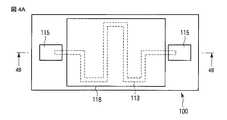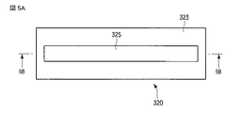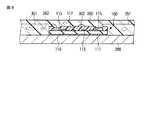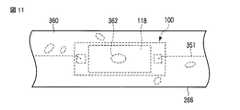JP2012196340A - Therapeutic treatment apparatus - Google Patents
Therapeutic treatment apparatusDownload PDFInfo
- Publication number
- JP2012196340A JP2012196340AJP2011063141AJP2011063141AJP2012196340AJP 2012196340 AJP2012196340 AJP 2012196340AJP 2011063141 AJP2011063141 AJP 2011063141AJP 2011063141 AJP2011063141 AJP 2011063141AJP 2012196340 AJP2012196340 AJP 2012196340A
- Authority
- JP
- Japan
- Prior art keywords
- heat
- main surface
- chip
- heat generating
- resistance pattern
- Prior art date
- Legal status (The legal status is an assumption and is not a legal conclusion. Google has not performed a legal analysis and makes no representation as to the accuracy of the status listed.)
- Granted
Links
Images
Landscapes
- Surgical Instruments (AREA)
Abstract
Translated fromJapaneseDescription
Translated fromJapanese本発明は、治療用処置装置に関する。 The present invention relates to a therapeutic treatment apparatus.
一般に、高周波エネルギや熱エネルギを用いて生体組織を治療する治療用処置装置が知られている。例えば特許文献1には、次のような治療用処置装置が開示されている。すなわち、この治療用処置装置は、処置対象である生体組織を把持する開閉可能な保持部を有している。この保持部の生体組織と接する部分には、高周波の電圧を印加するための高周波電極と、その高周波電極を加熱するための発熱チップとが配設されている。また、保持部には、カッタが備えられている。このような治療用処置装置の使用においては、まず、生体組織を保持部で把持し、高周波の電圧を印加する。更に、保持部材で生体組織を加熱することで、生体組織を吻合する。また、保持部に備えられたカッタにより、生体組織端部を接合した状態で切除することも可能である。 In general, therapeutic treatment apparatuses that treat living tissue using high-frequency energy or thermal energy are known. For example,
特許文献1に開示されているような治療用処置装置においては、小型の発熱チップが、高周波電極に離散的に配置されている。この発熱チップで発生した熱を効率よく高周波電極に伝えるために、また、発熱チップを電気的に絶縁するために、発熱チップは、熱伝導率が低く絶縁性を有する封止剤による封止膜で覆われている。しかしながら、この封止膜の形成時に局部的な空気層が混入することがある。この空気層の部分は他の部分と熱伝導率が異なるため、空気層が混入すると、熱流に不規則性が生じ、特に発熱チップにおいて局部的に高温となる場所ができる可能性がある。このような局部的な温度上昇は、予測が困難であり、当該治療用処置装置にとって望ましくない。 In the therapeutic treatment apparatus as disclosed in
そこで本発明は、封止膜に空気層が生じても、発熱チップの温度が局部的に上昇することを防止した治療用処置装置を提供することを目的とする。 Therefore, an object of the present invention is to provide a therapeutic treatment apparatus that prevents the temperature of a heat generating chip from locally rising even if an air layer is generated in a sealing film.
前記目的を果たすため、本発明の治療用処置装置の一態様は、生体組織を目標温度で加熱して治療するための治療用処置装置であって、表裏をなす第1の主面と第2の主面のうち該第1の主面において前記生体組織に接触して該生体組織に熱を伝える伝熱部と、表裏をなす第3の主面と第4の主面のうち、該第3の主面側に電気抵抗パターンが形成され、該第4の主面において前記伝熱部の前記第2の主面と接合し、該電気抵抗パターンに電力を投入することで前記伝熱部を加熱する発熱チップと、前記電気抵抗パターンを挟んで前記伝熱部と対峙するように前記発熱チップの前記第3の主面に配置された第1の熱伝導率を有する均熱部材と、前記伝熱部の前記第2の主面、前記発熱チップ、及び前記均熱部材を覆い、前記第1の熱伝導率よりも低い第2の熱伝導率を有する封止部材と、を具備することを特徴とする。 In order to achieve the above object, one embodiment of the therapeutic treatment apparatus of the present invention is a therapeutic treatment apparatus for heating and treating a living tissue at a target temperature, and includes a first main surface and a second main surface that are front and back. Of the main surfaces of the first and second surfaces, the first main surface contacts the living tissue and transfers heat to the living tissue, and the third main surface and the fourth main surface forming the front and back surfaces, 3 is formed with an electric resistance pattern on the main surface side, joined to the second main surface of the heat transfer portion on the fourth main surface, and electric power is supplied to the electric resistance pattern so that the heat transfer portion A heat-generating chip that heats the heat-resistance part, and a heat-uniforming member that has a first thermal conductivity disposed on the third main surface of the heat-generating chip so as to face the heat transfer portion across the electrical resistance pattern; Covering the second main surface of the heat transfer section, the heat generating chip, and the heat equalizing member, according to the first thermal conductivity. Characterized by comprising a sealing member having a lower second thermal conductivity, the.
本発明によれば、発熱チップと封止膜となる封止部材との間に均熱部材が介在しているので、封止膜に空気層が生じても、発熱チップの温度が局部的に上昇することを防止した治療用処置装置を提供できる。 According to the present invention, since the soaking member is interposed between the heat generating chip and the sealing member serving as the sealing film, even if an air layer is generated in the sealing film, the temperature of the heat generating chip is locally increased. It is possible to provide a therapeutic treatment apparatus that prevents the elevation.
[第1の実施形態]
まず、本発明の第1の実施形態について図面を参照して説明する。本実施形態に係る治療用処置装置は、生体組織の治療に用いるための、生体組織に高周波エネルギと熱エネルギとを作用させる装置である。図1に示すように、治療用処置装置210は、エネルギ処置具212と、エネルギ源214と、フットスイッチ216とを備えている。[First Embodiment]
First, a first embodiment of the present invention will be described with reference to the drawings. The therapeutic treatment apparatus according to the present embodiment is an apparatus that causes high-frequency energy and thermal energy to act on a living tissue for use in treatment of the living tissue. As shown in FIG. 1, the
エネルギ処置具212は、例えば腹壁を貫通させて処置を行うための、リニアタイプの外科治療用処置具である。エネルギ処置具212は、ハンドル222と、ハンドル222に取り付けられたシャフト224と、シャフト224の先端に設けられた保持部226とを有する。保持部226は、開閉可能であり、処置対象の生体組織を保持して、凝固、切開等の処置を行う処置部である。以降説明のため、保持部226側を先端側と称し、ハンドル222側を基端側と称する。ハンドル222は、保持部226を操作するための複数の操作ノブ232を備えている。なお、ここで示したエネルギ処置具212の形状は、もちろん一例であり、同様の機能を有していれば、他の形状でもよい。例えば、鉗子のような形状をしていてもよいし、シャフトが湾曲していてもよい。 The energy treatment device 212 is a linear type surgical treatment device for performing treatment by penetrating the abdominal wall, for example. The energy treatment device 212 includes a handle 222, a
ハンドル222は、ケーブル228を介してエネルギ源214に接続されている。エネルギ源214には、フットスイッチ216が接続されている。足で操作するフットスイッチ216は、手で操作するスイッチやその他のスイッチに置き換えてもよい。フットスイッチ216のペダルを術者が操作することにより、エネルギ源214からエネルギ処置具212へのエネルギの供給のON/OFFが切り換えられる。 The handle 222 is connected to the
保持部226及びシャフト224の構造の一例を図2に示す。図2(A)は保持部226が閉じた状態を示し、図2(B)は保持部226が開いた状態を示す。シャフト224は、筒体242とシース244とを備えている。筒体242は、その基端部でハンドル222に固定されている。シース244は、筒体242の外周に、筒体242の軸方向に沿って摺動可能に配設されている。 An example of the structure of the
筒体242の先端部には、保持部226が配設されている。保持部226は、第1の保持部材260と、第2の保持部材270とを備えている。第1の保持部材260の基部は、シャフト224の筒体242の先端部に固定されている。一方、第2の保持部材270の基部は、シャフト224の筒体242の先端部に、支持ピン256によって、回動可能に支持されている。したがって、第2の保持部材270は、支持ピン256の軸回りに回動し、第1の保持部材260に対して開いたり閉じたりする。 A
保持部226が閉じた状態では、第1の保持部材260の基部と、第2の保持部材270の基部とを合わせた断面形状は、円形となる。第2の保持部材270は、第1の保持部材260に対して開くように、例えば板バネなどの弾性部材258により付勢されている。シース244を、筒体242に対して先端側にスライドさせ、シース244によって第1の保持部材260の基部及び第2の保持部材270の基部を覆うと、図2(A)に示すように、弾性部材258の付勢力に抗して、第1の保持部材260及び第2の保持部材270は閉じる。一方、シース244を、筒体242の基端側にスライドさせると、図2(B)に示すように、弾性部材258の付勢力によって第1の保持部材260に対して第2の保持部材270は開く。 In a state where the holding
筒体242には、後述する第1の高周波電極266又は第2の高周波電極276に接続される高周波電極用通電ライン268と、発熱部材である発熱チップ100に接続される発熱チップ用通電ライン281,282とが挿通されている。
筒体242の内部には、その基端側で操作ノブ232の一つと接続した駆動ロッド252が、筒体242の軸方向に沿って移動可能に配設されている。駆動ロッド252の先端側には、先端側に刃が形成された薄板状のカッタ254が配設されている。操作ノブ232を操作すると、駆動ロッド252を介してカッタ254は、筒体242の軸方向に沿って移動させられる。カッタ254が先端側に移動するとき、カッタ254は、保持部226に形成された後述するカッタ案内溝264,274内に収まる。The
A
第1の保持部材260は、第1の保持部材本体262を有し、第2の保持部材270は、第2の保持部材本体272を有する。図3に示すように、第1の保持部材本体262には、前記したカッタ254を案内するためのカッタ案内溝264が形成されている。第1の保持部材本体262には、凹部が設けられ、そこには例えば銅の薄板で形成された第1の高周波電極266が配設されている。第1の高周波電極266は、カッタ案内溝264を有するので、その平面形状は、図3(A)に示すように、略U字形状となっている。 The
また、後に詳述するように、第1の高周波電極266の第1の保持部材本体262側の面には、複数の発熱チップ100が接合されている。この発熱チップ100と、発熱チップ100への配線等と、第1の高周波電極266とを覆うように、例えばシリコーンからなる封止剤が塗布されて封止膜360が形成されている。
第1の高周波電極266には、図2に示すように、高周波電極用通電ライン268が電気的に接続している。第1の高周波電極266は、この高周波電極用通電ライン268を介して、ケーブル228に接続されている。As will be described in detail later, a plurality of
As shown in FIG. 2, a high-frequency
第2の保持部材270は、第1の保持部材260と対称をなす形状をしている。すなわち、第2の保持部材270には、カッタ案内溝264と対向する位置に、カッタ案内溝274が形成されている。また、第2の保持部材本体272には、第1の高周波電極266と対向する位置に、第2の高周波電極276が配設されている。第2の高周波電極276は、高周波電極用通電ライン268を介して、ケーブル228に接続されている。 The
閉じた状態の保持部226が生体組織を把持する際には、把持された生体組織は、第1の高周波電極266及び第2の高周波電極276と接触する。
第1の保持部材本体262及び第2の保持部材本体272は更に、第1の高周波電極266及び第2の高周波電極276に接した生体組織を焼灼するために、発熱のための機構を有する。第1の保持部材本体262に設けられた発熱機構と、第2の保持部材本体272に設けられた発熱機構とは、同様の形態を持つ。ここでは第1の保持部材本体262に形成された発熱機構を例に挙げて説明する。When the holding
The first holding member
まず、この発熱の機構を構成する、発熱チップ100、中継チップ320、及び接続チップ330について説明する。発熱チップ100は、図4A及び図4Bに示すように、アルミナ製の基板111を用いて形成されている。基板111の主面の一方である表面には、発熱用のPt薄膜である抵抗パターン113が形成されている。また、基板111の表面の、長方形の2つの短辺近傍には、それぞれ矩形の電極115が形成されている。ここで、電極115は、抵抗パターン113のそれぞれの端部に接続している。 First, the
電極115が形成されている部分を除き、抵抗パターン113上を含む基板111の表面には、例えばポリイミドで形成された絶縁膜117が形成されている。さらに、絶縁膜117の上面には、基板111の抵抗パターン113及び絶縁膜117を含む側の熱的不均一さを小さくするために、熱伝導性のよい物質で形成された均熱部材118が設けられている。均熱部材118の材料は、金属、特に銅やアルミニウム等が好ましい。なお、抵抗パターン113と均熱部材118とは、絶縁膜117によって、電気的に絶縁されることになる。 An insulating
基板111の裏面全面には、接合用金属層119が形成されている。電極115と接合用金属層119とは、例えばTiとCuとNiとAuとからなる多層の膜である。これら電極115と接合用金属層119とは、ワイヤーボンディングやハンダ付けに対して安定した強度を有している。接合用金属層119は、例えば第1の高周波電極266に発熱チップ100をハンダ付けする際に、接合が安定するように設けられている。 A
中継チップ320について、図5Aと図5Bとを参照して説明する。中継チップ320は、発熱チップ100と同様に、アルミナ製の基板323を用いて形成されている。基板323の表面には、電極325が形成されている。また、基板323の裏面全面には、接合用金属層327が形成されている。発熱チップ100の場合と同様に、電極325と接合用金属層327とは、例えばTiとCuとNiとAuとからなる多層の膜である。 The
接続チップ330も、中継チップ320と同様の構成を有している。図6に示すように、接続チップ330は、アルミナ製の基板333と、基板333の表面に形成された電極339と、基板333の裏面全面に形成されている接合用金属層とを有している。 The
発熱チップ100、中継チップ320、及び接続チップ330は、第1の高周波電極266及び第2の高周波電極276の、生体組織と接する面(第1の主面)とは反対側の面(第2の主面)に配設されている。ここで、発熱チップ100、中継チップ320、及び接続チップ330は、それぞれ、接合用金属層の表面と第1の高周波電極266又は第2の高周波電極276の第2の主面とをハンダ付けすることにより固定されている。 The
第1の高周波電極266の場合を例に挙げて、図7を参照して説明する。第1の高周波電極266の基端部には、カッタ案内溝264を挟んで対称な位置に接続チップ330が配置されている。
第1の高周波電極266には、6個の発熱チップ100が、図7に示すように配置されている。すなわち、発熱チップ100は、基端側から先端側に向けてカッタ案内溝264を挟んで対称に2列に3個ずつ並べて配置されている。ここで、発熱チップ100は、それぞれ2つの電極115のうち一方を先端側に他方を基端側に向けて配置されている。第1の高周波電極266の先端部分には、中継チップ320が配置されている。The case of the first high-
On the first high-
2つの接続チップ330には、それぞれ発熱チップ用通電ライン281,282がハンダ付けされている。発熱チップ用通電ライン281と発熱チップ用通電ライン282とは、対をなしており、ケーブル228を介してエネルギ源214に接続されている。 The two
接続チップ330の電極339の先端側と、それらと隣接する発熱チップ100の電極115とは、ワイヤーボンディングによって形成されたワイヤー351により接続されている。同様に、各接続チップの隣接する電極115同士は、それぞれワイヤーボンディングによって形成されたワイヤー351により接続されている。また、最も先端側に配置された2つの発熱チップ100の先端側の電極115は、それぞれ中継チップ320の電極325に、ワイヤーボンディングによって形成されたワイヤー351により接続されている。中継チップ320を介して接続するのは、第1の高周波電極266の長手方向に並ぶ発熱チップ100の間隔よりも、第1の高周波電極266の先端部において第1の高周波電極266の長手方向と直交する方向に配置された2つの発熱チップ100の間隔が大きく、ワイヤーボンディングによる接続が困難であるからである。以上によって、発熱チップ用通電ライン281、6つの発熱チップ100の抵抗パターン113、及び発熱チップ用通電ライン282は、直列に接続される。 The tip side of the
第1の高周波電極266上には、発熱チップ100、中継チップ320、並びに接続チップ330、及びそれらを接続するワイヤー351を覆うように、例えばシリコーンからなる封止剤が塗布されて、封止膜360が図3に示すように形成されている。ここで、封止膜360は、均熱部材118の熱伝導率(第1の熱伝導率)よりも低い熱伝導率(第2の熱伝導率)を有している。 On the first high-
エネルギ源214から出力された電流は、6つの発熱チップ100のそれぞれの抵抗パターン113を流れる。その結果、各抵抗パターン113は発熱する。抵抗パターン113が発熱すると、第1の高周波電極266にその熱が伝達される。この熱により、第1の高周波電極266に接した生体組織が焼灼される。 The current output from the
発熱チップ100で生じた熱を効率よく第1の高周波電極266へ伝えるために、封止膜360、及びその周囲の第1の保持部材本体262は、低い熱伝導率を有するように構成されることが好ましい。前述のとおり、封止膜360の熱伝導率は、均熱部材118の熱伝導率よりも低い。そして、封止膜360の熱伝導率は、第1の高周波電極266や基板111の熱伝導率よりも低いことが好ましい。封止膜360及び第1の保持部材本体262の熱伝導率が低いことで、損失の少ない熱伝導が実現される。 In order to efficiently transmit heat generated in the
なお、上記説明では、製造工程を考慮して、均熱部材118は、発熱チップ100の一部として形成されているものとして説明したが、均熱部材118を有さない発熱チップの、第1の高周波電極266又は第2の高周波電極276の第2の主面と接合する第3の主面とは反対側の第4の主面(抵抗パターン113が形成されている側の面)に、均熱部材118として機能する例えば金属膜を、別体として貼り合わせるように構成しても、後述する機能及び効果と同様の機能及び効果が得られることはもちろんである。 In the above description, the
このように、例えば第1の高周波電極266又は第2の高周波電極276は、生体組織に熱を伝える伝熱部として機能し、例えば抵抗パターン113は、電気抵抗パターンとして機能し、例えば発熱チップ100は、第3の主面側に電気抵抗パターンが形成され、第4の主面において前記伝熱部と接合し、当該電気抵抗パターンに電力を投入することで当該伝熱部を加熱する発熱チップとして機能し、例えば均熱部材118は、電気抵抗パターンを挟んで伝熱部と対峙するように発熱チップの第3の主面に配置された第1の熱伝導率を有する均熱部材として機能し、例えば封止膜360は、前記伝熱部の第2の主面、発熱チップ、及び均熱部材を覆い、第1の熱伝導率よりも低い第2の熱伝導率を有する封止部材として機能する。 Thus, for example, the first high-
次に本実施形態に係る治療用処置装置210の動作を説明する。術者は、予めエネルギ源214の入力部を操作して、治療用処置装置210の出力条件、例えば、高周波エネルギ出力の設定電力、熱エネルギ出力の目標温度、加熱時間等を設定しておく。それぞれの値を個別に設定するように構成してもよいし、術式に応じた設定値のセットを選択するように構成してもよい。 Next, the operation of the
エネルギ処置具212の保持部226及びシャフト224は、例えば、腹壁を通して腹腔内に挿入される。術者は、操作ノブ232を操作して、保持部226を開閉させ、第1の保持部材260と第2の保持部材270とによって、処置対象の生体組織を把持する。このとき、第1の保持部材260に設けられた第1の高周波電極266と第2の保持部材270に設けられた第2の高周波電極276との両方の第1の主面に、処置対象の生体組織が接触している。 The holding
術者は、保持部226によって処置対象の生体組織を把持したら、フットスイッチ216を操作する。フットスイッチ216がONに切り換えられると、エネルギ源214から、ケーブル228を介して第1の高周波電極266及び第2の高周波電極276に、予め設定した設定電力の高周波電力が供給される。供給される電力は、例えば、20W〜80W程度である。その結果、生体組織は発熱し、組織が焼灼される。この焼灼により、当該組織は変性し、凝固する。 When the operator grasps the biological tissue to be treated by the holding
次にエネルギ源214は、高周波エネルギの出力を停止した後、第1の高周波電極266の温度が目標温度になるように発熱チップ100に電力を供給する。ここで、目標温度は、例えば100℃〜300℃である。このとき電流は、エネルギ源214から、ケーブル228、発熱チップ用通電ライン281,282、接続チップ330、及びワイヤー351を介して、各発熱チップ100の抵抗パターン113を流れる。各発熱チップ100の抵抗パターン113は、電流によって発熱する。抵抗パターン113で発生した熱は、基板111及び接合用金属層119を介して、当該発熱チップ100の第4の主面とその第2の主面とが接合している第1の高周波電極266に伝わる。その結果、第1の高周波電極266の温度は上昇する。同様に、第2の高周波電極276の温度も、第2の高周波電極276に配置された各発熱チップ100を流れる電流による発熱で上昇する。その結果、第1の高周波電極266又は第2の高周波電極276の第1の主面と接触している生体組織は更に焼灼され、更に凝固する。
加熱によって生体組織が凝固したら、熱エネルギの出力を停止する。最後に術者は、操作ノブ232を操作してカッタ254を移動させ、生体組織を切断する。以上によって生体組織の処置が完了する。Next, after stopping the output of the high frequency energy, the
When the living tissue is solidified by heating, the output of thermal energy is stopped. Finally, the operator operates the
ここで、均熱部材118が配置されている効果について説明する。仮に均熱部材118が存在しなかった場合の、第1の高周波電極266、発熱チップ100、及び封止膜360部分の拡大断面図を図8に示す。第1の高周波電極266及び発熱チップ100等を覆う封止膜360には、製造過程で生じざるを得ないボイドなどに起因した局部的な空気層362が混入することがある。この空気層362の熱伝導率は、封止膜360のその他の部分の熱伝導率よりも非常に低い。このため、空気層362が、発熱チップ100の絶縁膜117に接して存在する場合、熱流を模式的に表すと図9に示すようになる。図9において矢印は、熱流を模式的に示している。図9において左に示したように、発熱チップ100の第3の主面側に形成された抵抗パターン113−1で発生した熱は、絶縁膜117を介して、封止膜360へと流れる。これに対して、図9において右に示したように、同じく第3の主面に形成された抵抗パターン113−2で発生した熱は、空気層362に遮られて、絶縁膜117から封止膜360へ流れにくくなっている。そのため、空気層362がある抵抗パターン113の近傍(例えば図9において斜線を付した部分)は、他の場所に比べて局所的に高温となる。その結果、高温となる部分で、抵抗パターン113が焼切れる可能性がある。 Here, the effect that the soaking | uniform-
上記に対して、本実施形態では、発熱チップ100の絶縁膜117と封止膜360との間に、均熱部材118が配置されている。本実施形態に係る第1の高周波電極266、発熱チップ100、及び封止膜360部分の拡大断面図を図10に、上面図を図11にそれぞれ示す。また、抵抗パターン113の周辺の熱流を図12に模式的に示す。図12において矢印は、熱流を模式的に示している。本実施形態の場合、発熱チップ100に接触して空気層362が形成されたとしても、図12に示すように、空気層362がある部分において、熱は、均熱部材118で拡散され、均熱部材118と封止膜360とが直接接している部分から、封止膜360へと流れる。その結果、図9を参照して説明したような、局所的に高温となる部分が生じない。 In contrast, in the present embodiment, the soaking
なお、均熱部材118の形状や大きさ等は、図4Aに示すようなものには限定されない。しかしながら、前記のような熱を拡散させる効果を得るために、均熱部材118は、少なくとも抵抗パターン113が形成されている位置の直上にあたる、抵抗パターン113に対応する位置には設けられていることが好ましい。 Note that the shape, size, and the like of the soaking
以上のように本実施形態によれば、均熱部材118の配置に基づく温度を均一化する効果により、発熱チップ100の温度が局部的に上昇することを防止できる。その結果、例えば抵抗パターン113の焼切れを含む発熱チップ100の損傷、すなわち、エネルギ処置具212の故障を防止することができる。以上のように、本実施形態によれば、耐久性の高い治療用処置装置を提供することができる。 As described above, according to the present embodiment, the temperature of the
[第2の実施形態]
次に、本発明の第2の実施形態について説明する。ここでは、第1の実施形態との相違点について説明し、同一の部分については同一の符号を付して、その説明は省略する。本実施形態に係る発熱チップ120の上面図を図13Aに、断面図を13Bにそれぞれ示す。これら図に示すように、本実施形態に係る発熱チップ120では、絶縁膜117には、貫通穴117aが設けられており、この貫通穴117aに形成された伝熱柱118aが、均熱部材118と基板111と接触している。この伝熱柱118aは、均熱部材118と同様に伝熱性のよい材料からなる。伝熱柱118aは、均熱部材118と一体として形成されてもよい。伝熱柱118aによって、金属層である均熱部材118とチップ基板である基板111とは、熱的に結合されている。なお、伝熱柱118aは、抵抗パターン113には接触しないように形成されている。このように、例えば伝熱柱118aは、熱結合部材として機能する。[Second Embodiment]
Next, a second embodiment of the present invention will be described. Here, differences from the first embodiment will be described, and the same portions will be denoted by the same reference numerals and description thereof will be omitted. A top view of the
本実施形態に係る発熱チップ120によれば、発熱チップ120の第3の主面側に形成された抵抗パターン113で発生した熱の流れは次のようになる。図14に、発熱チップ120における熱流を模式的に示す。ここで図14において矢印は、熱流を模式的に示している。この図に示すように、第1の実施形態と同様に、封止膜360に生じた空気層362が発熱チップ100と接しても、熱は、均熱部材118により拡散して、局所的に高温となることを防止することができる。さらに、均熱部材118内を拡散した熱は、伝熱柱118aを介して、基板111に流れる。 According to the
ここで、封止膜360には、前記のとおり熱伝導率が低い物質を用いており、封止膜360の熱伝導率は、基板111の熱伝導率よりも低い。したがって、均熱部材118で拡散した熱は、封止膜360よりも基板111へより多く流れる。その結果、発熱チップ120の第4の主面とその第2の主面が接合している第1の高周波電極266への熱伝導の効率が上昇する。すなわち、抵抗パターン113で発生した熱を、より効率的に用いることができる。 Here, the sealing
以上のように本実施形態によれば、第1の実施形態の場合と同様に、均熱部材118の配置に基づく温度を均一化する効果により、発熱チップ100の温度が局部的に上昇することを防止することができる。その結果、例えば抵抗パターン113の焼切れを含む発熱チップ100の損傷、すなわち、エネルギ処置具212の故障を防止することができ、耐久性の高い治療用処置装置を提供することができる。さらに、伝熱柱118aにより、熱を基板111に流し、第1の高周波電極266を加熱するための熱の割合を増加させることができる。その結果、エネルギ効率の高い治療用処置装置を提供することができる。 As described above, according to the present embodiment, similarly to the first embodiment, the temperature of the
なお、本発明は上記実施形態そのままに限定されるものではなく、実施段階ではその要旨を逸脱しない範囲で構成要素を変形して具体化できる。また、上記実施形態に開示されている複数の構成要素の適宜な組み合わせにより、種々の発明を形成できる。例えば、実施形態に示される全構成要素から幾つかの構成要素を削除しても、発明が解決しようとする課題の欄で述べられた課題が解決でき、かつ、発明の効果が得られる場合には、この構成要素が削除された構成も発明として抽出され得る。 Note that the present invention is not limited to the above-described embodiment as it is, and can be embodied by modifying the constituent elements without departing from the scope of the invention in the implementation stage. In addition, various inventions can be formed by appropriately combining a plurality of components disclosed in the embodiment. For example, even if some constituent elements are deleted from all the constituent elements shown in the embodiment, the problem described in the column of problems to be solved by the invention can be solved and the effect of the invention can be obtained. The configuration in which this component is deleted can also be extracted as an invention.
100…発熱チップ、111…基板、113…抵抗パターン、115…電極、117…ポリイミド膜、117a…貫通穴、118…均熱部材、118a…伝熱柱、119…接合用金属層、120…発熱チップ、210…治療用処置装置、212…エネルギ処置具、214…エネルギ源、216…フットスイッチ、222…ハンドル、224…シャフト、226…保持部、228…ケーブル、232…操作ノブ、242…筒体、244…シース、252…駆動ロッド、254…カッタ、256…支持ピン、258…弾性部材、260…第1の保持部材、262…第1の保持部材本体、264,274…カッタ案内溝、266…第1の高周波電極、268…高周波電極用通電ライン、270…第2の保持部材、272…第2の保持部材本体、276…第2の高周波電極、281,282…発熱チップ用通電ライン、320…中継チップ、323…基板、325…電極、327…接合用金属層、330…接続チップ、333…基板、339…電極、351…ワイヤー、360…封止膜、362…空気層。 DESCRIPTION OF
Claims (5)
Translated fromJapanese表裏をなす第1の主面と第2の主面のうち該第1の主面において前記生体組織に接触して該生体組織に熱を伝える伝熱部と、
表裏をなす第3の主面と第4の主面のうち、該第3の主面側に電気抵抗パターンが形成され、該第4の主面において前記伝熱部の前記第2の主面と接合し、該電気抵抗パターンに電力を投入することで前記伝熱部を加熱する発熱チップと、
前記電気抵抗パターンを挟んで前記伝熱部と対峙するように前記発熱チップの前記第3の主面に配置された第1の熱伝導率を有する均熱部材と、
前記伝熱部の前記第2の主面、前記発熱チップ、及び前記均熱部材を覆い、前記第1の熱伝導率よりも低い第2の熱伝導率を有する封止部材と、
を具備することを特徴とする治療用処置装置。A therapeutic treatment device for heating and treating a living tissue at a target temperature,
Of the first main surface and the second main surface forming the front and back, a heat transfer section that contacts the living tissue on the first main surface and transfers heat to the living tissue;
Of the third main surface and the fourth main surface forming the front and back, an electric resistance pattern is formed on the third main surface side, and the second main surface of the heat transfer section is formed on the fourth main surface. And a heating chip that heats the heat transfer part by applying power to the electrical resistance pattern,
A soaking member having a first thermal conductivity disposed on the third main surface of the heat generating chip so as to face the heat transfer portion across the electrical resistance pattern;
A sealing member that covers the second main surface of the heat transfer section, the heat generating chip, and the heat equalizing member, and has a second thermal conductivity lower than the first thermal conductivity;
A therapeutic treatment apparatus comprising:
前記金属層と前記チップ基板とは、前記電気抵抗パターンと接しない前記第2の熱伝導率よりも高い熱伝導率を有する熱結合部材によって、熱的に結合されている、
ことを特徴とする請求項3に記載の治療用処置装置。The electrical resistance pattern is formed on a chip substrate of the heat generating chip,
The metal layer and the chip substrate are thermally coupled by a thermal coupling member having a thermal conductivity higher than the second thermal conductivity that is not in contact with the electrical resistance pattern.
The therapeutic treatment device according to claim 3.
Priority Applications (1)
| Application Number | Priority Date | Filing Date | Title |
|---|---|---|---|
| JP2011063141AJP5704985B2 (en) | 2011-03-22 | 2011-03-22 | Therapeutic treatment device |
Applications Claiming Priority (1)
| Application Number | Priority Date | Filing Date | Title |
|---|---|---|---|
| JP2011063141AJP5704985B2 (en) | 2011-03-22 | 2011-03-22 | Therapeutic treatment device |
Publications (3)
| Publication Number | Publication Date |
|---|---|
| JP2012196340Atrue JP2012196340A (en) | 2012-10-18 |
| JP2012196340A5 JP2012196340A5 (en) | 2014-03-13 |
| JP5704985B2 JP5704985B2 (en) | 2015-04-22 |
Family
ID=47179207
Family Applications (1)
| Application Number | Title | Priority Date | Filing Date |
|---|---|---|---|
| JP2011063141AExpired - Fee RelatedJP5704985B2 (en) | 2011-03-22 | 2011-03-22 | Therapeutic treatment device |
Country Status (1)
| Country | Link |
|---|---|
| JP (1) | JP5704985B2 (en) |
Cited By (3)
| Publication number | Priority date | Publication date | Assignee | Title |
|---|---|---|---|---|
| WO2016166817A1 (en)* | 2015-04-14 | 2016-10-20 | オリンパス株式会社 | Therapeutic energy-imparting structure, and medical treatment device |
| WO2018198339A1 (en)* | 2017-04-28 | 2018-11-01 | オリンパス株式会社 | Energy treatment tool and treatment system |
| CN113543738A (en)* | 2018-12-10 | 2021-10-22 | 博世健康爱尔兰有限公司 | Ceramic applicator for transcutaneous energy delivery |
Citations (4)
| Publication number | Priority date | Publication date | Assignee | Title |
|---|---|---|---|---|
| JPH0682051A (en)* | 1992-09-07 | 1994-03-22 | Matsushita Electric Ind Co Ltd | Electric floor heating device |
| JPH08305197A (en)* | 1995-05-10 | 1996-11-22 | Brother Ind Ltd | Heating roller for fixing |
| JP2005348820A (en)* | 2004-06-08 | 2005-12-22 | Olympus Corp | Heating element, medical treatment tool and apparatus using thereof |
| US20090248002A1 (en)* | 2008-04-01 | 2009-10-01 | Tomoyuki Takashino | Treatment system, and treatment method for living tissue using energy |
- 2011
- 2011-03-22JPJP2011063141Apatent/JP5704985B2/ennot_activeExpired - Fee Related
Patent Citations (6)
| Publication number | Priority date | Publication date | Assignee | Title |
|---|---|---|---|---|
| JPH0682051A (en)* | 1992-09-07 | 1994-03-22 | Matsushita Electric Ind Co Ltd | Electric floor heating device |
| JPH08305197A (en)* | 1995-05-10 | 1996-11-22 | Brother Ind Ltd | Heating roller for fixing |
| JP2005348820A (en)* | 2004-06-08 | 2005-12-22 | Olympus Corp | Heating element, medical treatment tool and apparatus using thereof |
| US20050288747A1 (en)* | 2004-06-08 | 2005-12-29 | Olympus Corporation | Heat generating element, medical therapeutic instrument implementing the same, and treatment apparatus |
| US20090248002A1 (en)* | 2008-04-01 | 2009-10-01 | Tomoyuki Takashino | Treatment system, and treatment method for living tissue using energy |
| JP2009247893A (en)* | 2008-04-01 | 2009-10-29 | Olympus Medical Systems Corp | Treatment system for therapy |
Cited By (8)
| Publication number | Priority date | Publication date | Assignee | Title |
|---|---|---|---|---|
| WO2016166817A1 (en)* | 2015-04-14 | 2016-10-20 | オリンパス株式会社 | Therapeutic energy-imparting structure, and medical treatment device |
| CN107427319A (en)* | 2015-04-14 | 2017-12-01 | 奥林巴斯株式会社 | Treatment assigns construction and medical intervention device with energy |
| US20180021079A1 (en)* | 2015-04-14 | 2018-01-25 | Olympus Corporation | Therapeutic energy applying structure and medical treatment device |
| JPWO2016166817A1 (en)* | 2015-04-14 | 2018-02-08 | オリンパス株式会社 | Therapeutic energy application structure and medical treatment apparatus |
| WO2018198339A1 (en)* | 2017-04-28 | 2018-11-01 | オリンパス株式会社 | Energy treatment tool and treatment system |
| US11666373B2 (en) | 2017-04-28 | 2023-06-06 | Olympus Corporation | Treatment system and energy treatment tool |
| CN113543738A (en)* | 2018-12-10 | 2021-10-22 | 博世健康爱尔兰有限公司 | Ceramic applicator for transcutaneous energy delivery |
| US12251152B2 (en) | 2018-12-10 | 2025-03-18 | Solta Medical Ireland Limited | Ceramic applicator for transcutaneous delivery of energy |
Also Published As
| Publication number | Publication date |
|---|---|
| JP5704985B2 (en) | 2015-04-22 |
Similar Documents
| Publication | Publication Date | Title |
|---|---|---|
| JP5631716B2 (en) | Therapeutic treatment device | |
| JP5988868B2 (en) | Therapeutic treatment device | |
| JP5931604B2 (en) | Therapeutic treatment device | |
| JP5988885B2 (en) | Therapeutic treatment device | |
| JP5622551B2 (en) | THERAPEUTIC TREATMENT DEVICE AND ITS CONTROL METHOD | |
| JP5687462B2 (en) | Therapeutic treatment device | |
| JP6274881B2 (en) | Therapeutic treatment device | |
| JP5797348B2 (en) | THERAPEUTIC TREATMENT DEVICE AND MANUFACTURING METHOD THEREOF | |
| JPWO2015022919A1 (en) | Treatment tool and treatment system | |
| JP2012239831A (en) | Therapeutic treatment apparatus | |
| JP2013106909A (en) | Therapeutic treatment apparatus | |
| JP5704985B2 (en) | Therapeutic treatment device | |
| JP6062130B1 (en) | Treatment tool | |
| JP2012165948A (en) | Treatment device for therapy and method for producing the same | |
| JP6458127B2 (en) | Therapeutic energy application structure and medical treatment apparatus | |
| JP2012249807A (en) | Treatment apparatus for therapy, and control method for the same | |
| JP2012249806A (en) | Treatment apparatus for therapy | |
| JP6000717B2 (en) | THERAPEUTIC TREATMENT DEVICE AND ITS CONTROL METHOD | |
| WO2018193493A1 (en) | Surgical tool | |
| WO2014148199A1 (en) | Therapeutic treatment device | |
| WO2018193492A1 (en) | Surgical tool | |
| JPWO2017163410A1 (en) | Energy treatment tool |
Legal Events
| Date | Code | Title | Description |
|---|---|---|---|
| A711 | Notification of change in applicant | Free format text:JAPANESE INTERMEDIATE CODE: A711 Effective date:20121101 | |
| A521 | Written amendment | Free format text:JAPANESE INTERMEDIATE CODE: A821 Effective date:20121102 | |
| A521 | Written amendment | Free format text:JAPANESE INTERMEDIATE CODE: A523 Effective date:20140124 | |
| A621 | Written request for application examination | Free format text:JAPANESE INTERMEDIATE CODE: A621 Effective date:20140124 | |
| A131 | Notification of reasons for refusal | Free format text:JAPANESE INTERMEDIATE CODE: A131 Effective date:20140909 | |
| A977 | Report on retrieval | Free format text:JAPANESE INTERMEDIATE CODE: A971007 Effective date:20140912 | |
| A521 | Written amendment | Free format text:JAPANESE INTERMEDIATE CODE: A523 Effective date:20141001 | |
| TRDD | Decision of grant or rejection written | ||
| A01 | Written decision to grant a patent or to grant a registration (utility model) | Free format text:JAPANESE INTERMEDIATE CODE: A01 Effective date:20150217 | |
| A61 | First payment of annual fees (during grant procedure) | Free format text:JAPANESE INTERMEDIATE CODE: A61 Effective date:20150224 | |
| R151 | Written notification of patent or utility model registration | Ref document number:5704985 Country of ref document:JP Free format text:JAPANESE INTERMEDIATE CODE: R151 | |
| S531 | Written request for registration of change of domicile | Free format text:JAPANESE INTERMEDIATE CODE: R313531 | |
| R350 | Written notification of registration of transfer | Free format text:JAPANESE INTERMEDIATE CODE: R350 | |
| R250 | Receipt of annual fees | Free format text:JAPANESE INTERMEDIATE CODE: R250 | |
| LAPS | Cancellation because of no payment of annual fees |
















